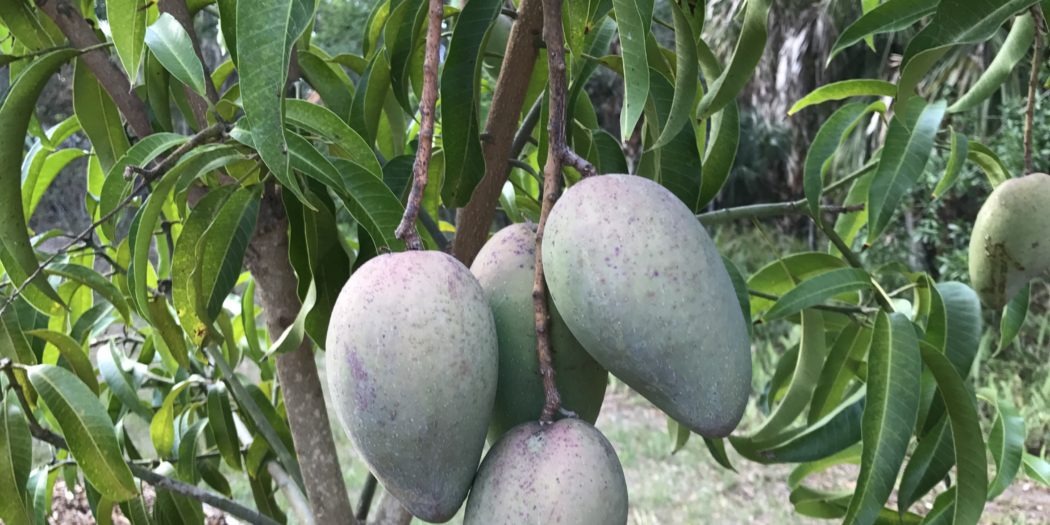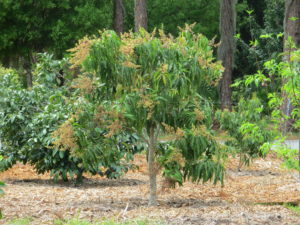
In the words of renowned tropical fruit expert Chris Rollins, there are mangos and there are all the other fruits. Eating a perfectly ripe locally grown SweetSong mango is a transcendent experience.
Mangos are usually hard when bought and allowed to ripen on the shelf. They are ripe when they have some give everywhere on the surface— the optimal point depends on the variety, and with experience one gains skill in the art. Often, though not always, ripeness is accompanies by aroma, especially at the stem end. Don’t be alarmed if ugly brown spots that may appear on the peel of a non-toxically grown mango. These are anthracnose fungus, perfectly harmless to people, and to the mango, unless they reach the point where the flesh starts to break down. If the mango was properly harvested, it will ripen before this happens. There may or may not be a change in coloration, again depending on the variety. If you check the SweetSong page for the variety, you’ll find out the easy way.
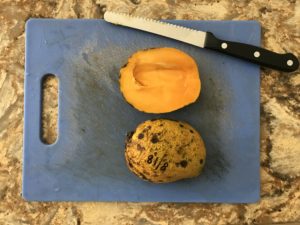
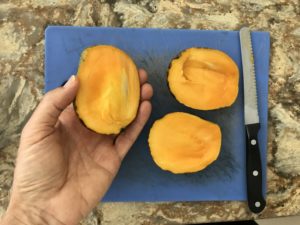
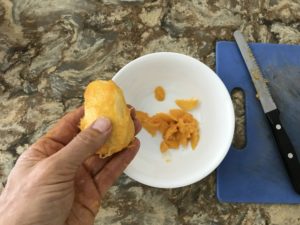
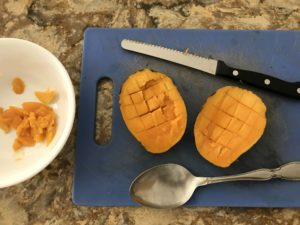
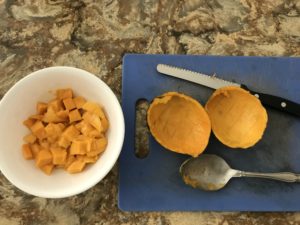 There are various methods for cutting a mango, but the most efficient is the crosscut method. These photos illustrate it on a SweetSong Neelam mango. Most any kitchen knife will work, but a serrated Wüsthof knife with rounded point is perfect. It utilizes the fact that mangos have a single large seed which is longest in the direction of the long axis of the mango, and flattened in the middle. The first two cuts remove the almost-halves from the middle part with the seed— once you become familiar with a particular variety of mango, you will get to know just how thin you can slice it. Then, cut the peel from the middle part and cut the mango off of the seed. For the halves, make crosscuts in the flesh, almost all the way to the peel, and then scoop out the flesh with a large spoon, automatically making cubical pieces. Very fast and efficient.
There are various methods for cutting a mango, but the most efficient is the crosscut method. These photos illustrate it on a SweetSong Neelam mango. Most any kitchen knife will work, but a serrated Wüsthof knife with rounded point is perfect. It utilizes the fact that mangos have a single large seed which is longest in the direction of the long axis of the mango, and flattened in the middle. The first two cuts remove the almost-halves from the middle part with the seed— once you become familiar with a particular variety of mango, you will get to know just how thin you can slice it. Then, cut the peel from the middle part and cut the mango off of the seed. For the halves, make crosscuts in the flesh, almost all the way to the peel, and then scoop out the flesh with a large spoon, automatically making cubical pieces. Very fast and efficient.
I have a Canadian friend who grew up in Bangladesh, and he groans when I cut mangos this way, finding it wasteful. He happily takes the seed and gnaws off the tasty remainder of the flesh on it, then goes to work on the peel until there is no remaining flesh on it. I say good for him— we Americans waste vast amounts of food.
There are at least five hundred known mango varieties— some say in the thousands— each with its own unique flavor and fruit and horticultural characteristics. At SweetSong, we grow about 30 excellent varieties: commercial workhorses Keitt and Kent, unusual varieties such as Cac and Kesar, trendy flavors from the Zill Nursery such as Sweet Tart, Fruit Punch, and Lemon Zest, and some extremely rare specimens such as Jin Huang, Amrapali, and Tyler Supreme.
With season-extending varieties, mango season here on Florida’s Suncoast runs from mid-spring into fall. That is, you’ve always got either paradise weather or fresh local mangos. You’re in the right place.
 SweetSong Groves LLC Tropical and subtropical fruit, ecologically grown on Florida's Suncoast
SweetSong Groves LLC Tropical and subtropical fruit, ecologically grown on Florida's Suncoast
